Spider veins, which are familiar to almost every adult, are medically called telangiectasia. Medical practice states that this phenomenon is observed in a quarter of women aged 20-35 years, as well as in 80% of those who have carried a child. Vascular network on the legs is considered as a cosmetic defect, but it is also a kind of symptom indicating that the body is exposed to negative influences.
Women mask capillaries on their faces with foundation, and on the body - with clothes. Men don’t even think about this phenomenon. As a result, complications of telangiectasia arise. If you do not start treatment in time, you will not be able to avoid varicose veins in the future.
Reasons for the formation of vascular networks on the legs
The defect consists of dilated areas of capillaries. Normally, their diameter does not exceed 0.02 mm, and with pathology it increases to 1.5 mm.
The stars appear as pink, red or blue spots riddled with a network of smaller vessels. The appearance of the defect depends on the cause of its appearance.
Red thin stars are formed from capillaries and arterioles, blue and wider ones are formed from venules. They appear in a variety of places. Thin red blood vessels are often noticeable on the face, nose, and cheeks (rosacea).
A patch of blue and red tree-like branches usually appears on the legs. For those who spend a lot of time in the sun, the neck and décolleté area are affected. People with thin and dry skin are more susceptible to star formation.
Reasons for the appearance of vascular network:
- Venous insufficiency;
- Hereditary predisposition;
- Liver diseases;
- Blood clotting disorder;
- Pregnancy and childbirth;
- Abuse of solarium, insolation, saunas and hot baths;
- Standing for a long time, for example, due to work, regularly wearing high-heeled shoes, lifting heavy objects;
- Obesity;
- Imbalance of sex hormones;
- Treatment with radiation methods, deep peeling procedure;
- Taking hormonal contraceptives;
- Frostbite of the skin;
- Flat feet, spinal diseases;
- Decreased vascular tone;
- Hypovitaminosis P and C.
The listed factors lead to pathological changes in the saphenous veins, as a result of which they expand and their walls lose their tone. Blood pressure rises, swelling and blood stagnation occur. Enlarged veins become more visible, and small vessels dilate and burst.
Clinical picture
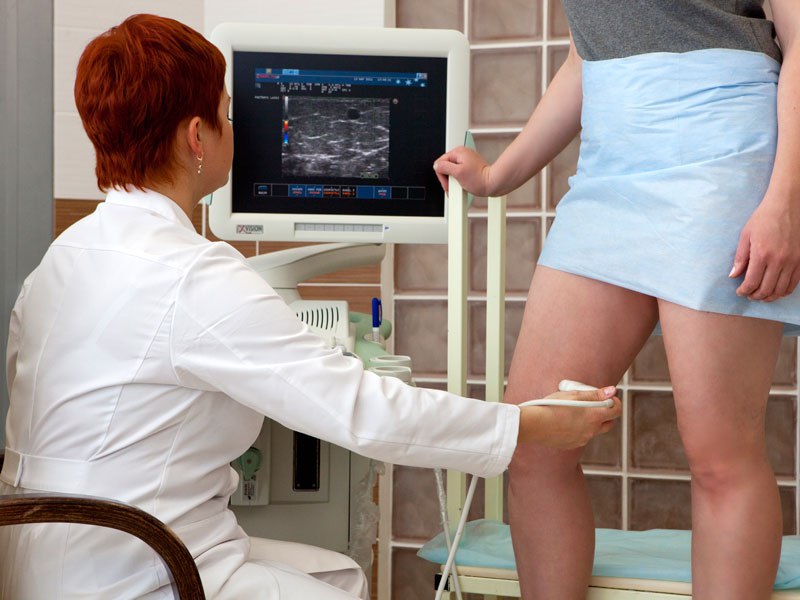
Spider veins actually appear as purple or red spots. They have an uneven surface, may rise slightly above the skin and have different sizes. If you press on the sore spot, it will turn pale.
A person may complain of soreness, tingling and a local increase in temperature in the area of the defect, as well as cramps. Spider veins can grow and transform into a tumor - hemangioma.
Diagnostic methods
Treatment of vascular networks that appear on the legs and other parts of the body should be carried out by a phlebologist.
Ultrasound examination allows assessing blood flow and vascular patency. The specialist will definitely prescribe a general and blood test for coagulation. It is necessary to check the functions of the liver and heart.
Removal of the vascular network formed on the legs
- Therapeutic. It consists of using special products for external use (creams, ointments). This series of drugs allows you to relieve pain and swelling, improve blood circulation, and prevent the progression of pathology. Conservative methods are not highly effective in treating existing stars. At the mild stage (small size of the defect, detected in a timely manner, without rupture of blood vessels), iontophoresis is used. This type of procedure does not have to be done in a medical facility. Many beauty salons offer similar services. The procedure involves exposure to direct current, which promotes the penetration of drugs into the skin. Iontophoresis is prescribed in courses - 10 sessions every six months. This measure allows you to narrow the lumens of blood vessels and prevent the progression of the defect;
- Radical methods. Only a phlebologist can choose these. A full-fledged study will eliminate not only the vascular network, but also the cause of its appearance. The most common options are: electrocoagulation, sclerotherapy, laser removal.
Remove vascular networks using microsclerotherapy on the legs
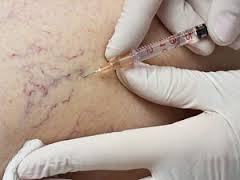
The method involves introducing a special drug into the vessel. The substance will destroy the wall of the vessel and eventually the latter will stick together. During the rehabilitation period (3-5 days), compression garments (stockings) are worn or elastic bandages are used. The number of procedures is determined by the attending physician. The interval between sessions is 2 weeks.
The microsclerotherapy method is painless and well tolerated by patients. The event is performed on an outpatient basis. Having processed large vessels, you can take on small ones.
Side effects include swelling, redness and irritation of the treated area. Such phenomena disappear after 2-3 weeks. Some people may experience increased sensitivity to the sclerosant, which will manifest itself in ulcers and scarring of the skin. The formation of blood clots cannot be ruled out, which leads to darkening (hyperpigmentation) of the skin.
Laser star removal
Such events are carried out only in specialized centers and medical institutions. The laser acts similar to microsclerotherapy: the walls of blood vessels absorb radiation, heat up and stick together. The surrounding tissues are cooled by a cryogenic generator. Basically, you need to undergo several procedures, with 6-week breaks between them.
The advantages of the method include painlessness, the ability to remove large spider veins, and an aesthetic result. There is no need to wear compression garments during the rehabilitation period. The laser can also be used in places inaccessible to microsclerotherapy - face, neck, back.
After removing blood vessels using this method, scars and burns may occur on the skin. During the rehabilitation period, it is necessary to protect yourself from direct solar radiation.
Cannot be used on the first day cosmetical tools. In some cases, swelling occurs, but it goes away quite quickly. Contraindications are dark and tanned skin, taking antibiotics and retinoid drugs.
How to remove stars using electrocoagulation
During the procedure, high-frequency current is used, which provokes coagulation of the proteins of the vessel walls and leads to a narrowing of the lumens. The method is mainly used for minor damage, up to 0.3 mm in diameter.
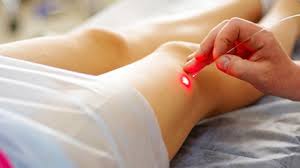
Among the advantages of electrocoagulation is the absence of scars. It can be used on any part of the body. The method has no contraindications regarding skin type, and during the rehabilitation period there is no need for compression garments.
Among the disadvantages, it is worth highlighting pain. During healing, crusts form on the skin. Under no circumstances should they be peeled off, and only after they come off on their own should you be allowed to use water and cosmetics.
If a vascular network appears on the legs or other part of the body, there is no guarantee that even after elimination it will not appear again.
It is imperative to follow measures to prevent relapse, for example, eat well, use compression garments if necessary, use products with a tonic effect, avoid excessive stress and factors that irritate blood vessels.
Cellulite is not the only problem women have when they have to hide their legs . The venous network on the legs is another unpleasant reason that spoils your mood. This is especially offensive in the summer, when you really want to buy beautiful skirts and...
It is with the onset of warm days that many women storm the Internet with the question: how to remove venous mesh on their legs.
What kind of bullshit is this?
Venous network or spider veins, or more correctly - telangiectasia(in medical terms) these are dilated capillaries and arteries that protrude on the skin in various patterns. And the capillaries expand due to loss of muscle tone and due to disruption of blood movement through the veins (stagnation).
By the way, venous patterns can “decorate” not only the legs, but also the chest, back and even the face. But much more often they appear on the legs.
- because you abuse high heels, overstraining your calf muscles;
- because often due to the nature of their work they are forced to sit or stand for a long time

- because even such a joyful event as pregnancy, due to the resulting hormonal imbalance, is the cause of the appearance of these unpleasant patterns. Or, even without pregnancy, a hormonal imbalance has occurred (often this occurs due to taking hormonal medications or contraceptives).
- because heredity
- because even your favorite sport, where there is significant stress on the legs, gives you this by-effect.
- because it is excess weight
- because the blood is too viscous. And it becomes like this due to a lack of fluid in the body. Learn to drink “living” water. Not tea, coffee, soda, but ordinary purified water (filtered).
Who should you complain to if you get caught online?
Certainly not the Internet or a friend. Much better than this one problem discuss with a phlebologist . It is worth turning to him, even when the mesh is still visible just a little, but by the evening your legs are already swelling, your shoes suddenly become too small, and from time to time there is pain in your calves.
After examination and ultrasound of the veins, the doctor will give a verdict and indicate ways to bypass this insidious disease. Veins are treated with a laser or with a special solution injected into the protruding veins.
No hospitalization is required. But bruises may appear, or you will need to wear compression garments (, tights...) for a while. Therefore, it is better to start treatment in advance, before the onset of the beach period.
What can you do at home?
Unfortunately, fully rely on folk remedies not worth it. If the mesh has already appeared, you will have to go to the doctor. But, if the matter is still at an early stage, then:
- change your shoes to more comfortable, soft ones;
- if you have excess weight, you will have to get rid of it;
- go in for sports. Even banal squats in the morning and cycling with legs are a wonderful prevention, but best view sport to combat spider veins - swimming.

- love contrast showers. Always start with your feet. This hardening will strengthen the walls of blood vessels and make them more elastic.
— sunscreen should be used every day in summer, even if going to the beach is not planned today;
— proper nutrition- the key to overall health. In this case, vitamins such as C and P (rutin) are needed. Load up on nuts and citrus legumes.
— after a shower, rub aloe juice into problem areas. Natural will also help Apple vinegar(part water and part vinegar). Soak a cloth in vinegar, wrap it around the legs, and wrap the film on top. Lie down with your legs elevated and rest.
- there are special creams in the pharmacy that are also effective, but only if you don’t put everything off until later, hoping that it will “go away on its own.”
Venous “masterpieces” on the body are not only a cosmetic problem. If you give up on yourself, you will develop a more serious illness - varicose veins, thrombosis... And this is much more serious.
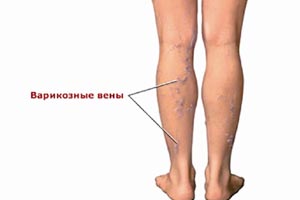
Venous mesh is most often observed in women over 27 years of age. It is located on the calves, under the knees and even on the thighs.
At the very initial stage of development of the disease, asterisks do not cause any trouble, with the exception of the aesthetic factor.
At first glance, vein networks are only a cosmetic drawback, but, as mentioned above, this is the initial manifestation of a more serious disease - varicose veins. If you do not start timely treatment, then other symptoms of varicose veins will join the vascular patterns on the legs: pain, a feeling of heaviness and fatigue in the lower extremities, as well as cramps, etc.
Venous mesh most often appears in women during pregnancy. It is at this time that the body undergoes serious changes.
Causes of vein veins
Venous networks appear due to strong expansion of superficial veins , the muscle-elastic fibers of the walls become weak and brittle.
The appearance of stars may also be caused by the weakening effects of female hormones on the muscles of the vein walls or damage to the nervous apparatus of the superficial veins. Dilated vessels, over time, expand even more and become more noticeable.
Stress and poor environment also leave their mark on the feet of young women and girls.
The cause of the appearance of a venous network on the legs may be excess weight, liver problems, and increased blood viscosity. For example, with an increase in blood viscosity, certain obstacles arise in the way of the outflow of venous blood to the heart from the periphery. As a result, the outflow of blood from the capillaries slows down and blood stagnates in the veins, which will inevitably lead to varicose venules and veins. Blood viscosity occurs due to special proteins produced by the liver.
In case of liver dysfunction not only does blood viscosity increase, but fatty hepatosis also develops, indicating a slowdown in metabolism. And with slow metabolic processes, as a rule, there is an increase in body weight and the formation of an even more noticeable “pattern” on the legs.
Spider veins can also be a clear factor indicating disorders in the lumbar spine , where the regulation of the body's metabolic processes occurs.
Disorders in the calf muscles can also cause the appearance of vein veins on the legs. Most women are often guilty of this themselves. Many fashionistas wear uncomfortable and tight platform shoes every day. high heels. Wearing such shoes leads to the fact that a push using contraction of the calf muscles and a smooth transfer of body weight to the toe from the heels becomes impossible. Ultimately, blood stagnation is created in the vessels and a spider vein appears.
But, whatever the cause of spider veins, it will inevitably lead to the development of more serious diseases - the formation of blood clots in blood vessels, hemorrhoids, and the development of varicose veins. Therefore, even if a barely noticeable pattern appears on your legs, you should immediately go to the doctor.
Treatment of vein veins
If a vascular pattern appears on the legs, treatment can be carried out without surgery. The most acceptable option for the treatment of venous “mesh” may be special creams containing high doses of vitamins Pro-K or K . These products are not only an excellent preventive measure for strengthening healthy blood vessels, but also help get rid of damaged, dilated vessels. However, all creams have one drawback - a long, cumulative effect. Treatment with creams and gels can last 3-6 months.
The most popular and fastest method of treating venous networks is sclerotherapy , but it also has a number of disadvantages and contraindications. For example, this method of eliminating spider veins is not recommended for patients with severe obesity. In fat patients, elastic bandages do not provide the necessary compression because they slip down very quickly. In addition, after compression sclerotherapy, the patient needs to actively move and walk more. If movement is impossible for any reason (cardiovascular failure, arthritis, paralysis, injury), then sclerotherapy will be useless.
Compression sclerotherapy is contraindicated for allergic reactions and acute infectious and inflammatory diseases.
At mild form Treatment of venous networks can also be carried out at home. First of all, you need to change your shoes to more comfortable ones. It is also recommended to avoid wearing clothes that are too tight as they slow down blood circulation. Swimming and other sports can also be a good solution in the fight for beautiful legs without “patterns”. It is advisable to add to your favorite sport the procedure of taking a contrast shower, which strengthens the walls of blood vessels and improves blood circulation in the extremities.
Vessels on the legs: can you get rid of them at home?
If a vascular network appears on your legs, you can get rid of it both with folk remedies and with the help of salon procedures, but first you need to understand the reasons for its formation: this will help prevent the occurrence of varicose veins in the future.
Vascular network on the legs: causes and treatment ^
When a vascular network appears on the legs, this indicates an expansion of the veins and capillaries located close to the surface of the skin. This problem must be solved immediately by contacting a phlebologist, because It will not go away on its own without proper treatment.
Reasons for the appearance of vascular networks on the legs:
- Heavy physical work, heavy load on the legs;
- Changes in hormonal levels;
- Frequent visits to the solarium, depilation and too rough massage;
- Having excess weight;
- Pregnancy, caring for the baby for the first year after birth, when women constantly carry the baby in their arms;
- Bad habits;
- Heredity;
- Wearing uncomfortable shoes.
Spider veins on the legs: how to get rid of them
Now there are many methods for treating vascular network on the legs, among which the following are the most popular:
- Laser correction, in which the mesh is simply removed;
- The use of special ointments and creams;
- Use of folk remedies.
If the network of blood vessels has just appeared and is not too noticeable, it can be eliminated by yourself in a simple way– take a contrast shower, which strengthens the walls of the capillaries. In all other cases, more effective treatment is required.
Vessels appear on the legs: what to do ^
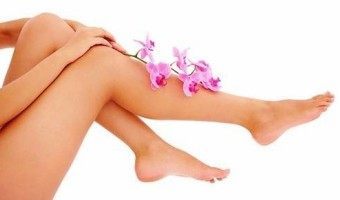
How to remove spider veins on your legs: home recipes
Laser removal of vascular networks on the legs
The best option is to remove the vascular network on the legs with a laser. The procedure itself is quite quick and easy, but requires preliminary preparation:
- 2 weeks before the session you need to avoid visiting baths, saunas and solariums;
- Completely remove hair from the surface of the skin on which laser treatment will be performed;
- On the day of the procedure, wear clothes made of light natural fabric so as not to further irritate the skin.
The actual removal of the vascular network on the legs occurs like this: the doctor sets up the laser device, turns on the cooling and begins to work on the network itself. The entire session lasts no more than half an hour, and the effect is visible after the first time. In general, complete elimination may require 3-4 treatments spaced 2 weeks apart.
Preparations and ointments for spider veins on the legs
To remove spider veins on your legs yourself and get rid of the symptoms of varicose veins, you can use the following means:
- Gel "Troxevasin": relieves swelling and heaviness in the legs, strengthens the walls of blood vessels and improves blood microcirculation;
- Gel "Venoruton": prevents the formation of blood clots, prevents the destruction and stretching of blood vessels;
- Cream for vascular network on the legs “Sofya”: makes the walls of blood vessels stronger, contains natural plant extracts;
- "Doctor Wen": cleanses and strengthens blood vessels.
Vascular network on the legs: treatment, folk recipes
For those who have vascular networks on their legs, treatment with folk remedies will be just right, because they are quite effective and do not require special skill in preparation.
There comes a time in the life of almost every girl and woman when her legs require more attention than usual. Increased fatigue, swelling, joint pain, inability to sleep due to muscle fatigue and the appearance of vascular networks - all this is the result of our active life, when rush comes first, and there is practically no time left to just rest. In order not to think about spider veins for as long as possible, you should know what preventive measures should be followed and how to treat spider veins that have already appeared on the legs.
What is a vascular network
The vascular network is the result of the expansion of veins, vessels and capillaries located in close proximity to the skin. Depending on the extent of distribution, complexity and causes, the vascular network may have a tree-like, stellate pattern or spread over the surface in spots. Most often, the localization of such manifestations is located on the legs, which will be discussed.
Causes of vascular network on the legs
Our legs are subject to constant stress. At the same time, not only standing work has a negative impact on them, but also constant sitting. However, that’s not all, because there are many reasons for the appearance of vascular networks on the legs.
- Weakening of the walls of blood vessels. Depending on many reasons, including general weakening of the body, vitamin deficiency, disruption of the cardiovascular system, obesity, diabetes, etc., the walls of blood vessels over time lose their elasticity, flexibility, and resistance to negative factors. They become more sensitive, which generally weakens them and makes them less susceptible not only to harmful substances, but also to beneficial ones. The permeability of blood vessels decreases, which provokes a slowdown in blood flow in one area or another, blockage of small capillaries and, as a result, their rupture.
- Hormonal fluctuations. A woman is a huge book of hormonal changes that have occurred to her throughout her life. It doesn't end with growing up, puberty and adolescence. It continues with periods of depression, when we are sad, hormonal surges, when we are in love, before and after conception, during pregnancy, when an abortion is necessary and at the birth of the baby, and then during his growing up - the list goes on and on. All this destabilizes the situation with blood vessels, making them most susceptible to the manifestation of vascular networks.
- Unreasonable use and application of “beauty” products. A lot can be included in this category. For example, excessive tanning, long stay exposure to active sun, frequent improper depilation and hair removal, including in the salon, improperly performed massages of the feet, legs and thighs. This also includes an unreasonable approach to losing weight. In particular, the abuse of “slimming” dietary supplements, diuretic products, teas and laxatives, and lack of adequate nutrition.
- Disproportionate to opportunity exercise stress. If you are into sports, just run in the morning, dance, etc. to maintain your figure and maintain vitality, this is very good. However, even in such a noble cause, we can all sometimes go too far, which will cause spider veins to “scatter” throughout our legs. The most common reason in this case is overworking of the legs during training, deliberate neglect of the pain syndrome in order to achieve one or another result.
- Incorrectly selected shoes. It's no secret that frequent walking in heels is one of the direct causes of spider veins, but not only high heels can contribute to this. Regular footwear, be it boots, sneakers or sandals, can significantly affect the health of your feet if they are not chosen for your feet - the wrong size or an uncomfortable last.
- Obesity, overweight, zero physical activity. All this is almost always accompanied by increased swelling of the legs and increased load on them.
- Heredity.
- Bad habits.
- Development of varicose veins. All of the above reasons can become both a cause and a consequence of the occurrence of this disease.
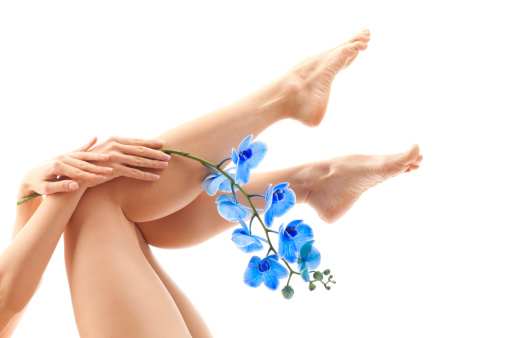
Treatment of vascular network
First of all, it is worth noting that in case of serious manifestations of the vascular network, you should immediately contact a phlebologist. It will help to examine in detail the causes of this disease and help in its treatment, which can take from several days to several months, depending on the complexity and scale of spread.
If spider veins and spider veins have only recently begun to bother you, and they appearance does not cause serious concern, then there is nothing easier than buying a special cream at the pharmacy, the range of which is quite large today. Sometimes such products are produced in the form of a balm, gel or even patches and are used in parallel with taking appropriate medications that are prescribed by a phlebologist. Now in pharmacies you can find paired complexes produced by the same company.
Also, in mild cases, you can use folk remedies. For example, lubricate the areas of spider veins with chilled aloe juice. Do this 7-10 times during the day, and repeat the entire procedure every other day. If your skin is sensitive, a slight burning sensation may occur when using aloe. You can also use halved fresh green tomatoes. They should be used to wipe the affected areas every evening.
If neither folk remedies, nor taking appropriate medications, nor the use of creams and gels gave the desired effect, or rather, you were not able to completely get rid of the external manifestation of the disease, then you can use salon procedures, including sclerotherapy, ozone therapy, photocoalation, laser exposure and elos-coagulation. IN extreme cases Surgical intervention is also used.
Prevention of spider veins
To prevent the appearance and development of vascular networks on the legs, there are several basic preventive measures:
- proper nutrition, drinking enough water;
- feasible daily physical activity (especially swimming and light running);
- daily walks;
- 10-15 minutes every day to self-massage your feet and let them relax;
- careful use of baths and saunas;
- weight control;
- choosing the right comfortable shoes;
- rejection of bad habits;
- therapeutic exercises for legs;
- professional massage;
- solving hormonal problems with the help of a gynecologist and endocrinologist, and not on your own;
- annual examination by a phlebologist;
- contrast shower and hardening;
- wearing compression stockings;
- warm-up for the legs during the working day to avoid increased swelling and pinching of blood capillaries.
